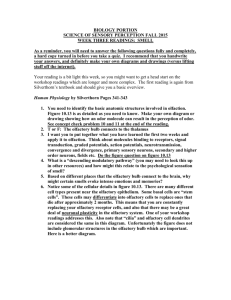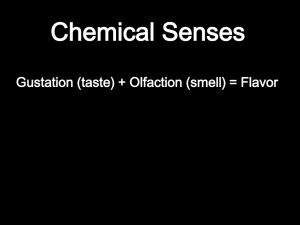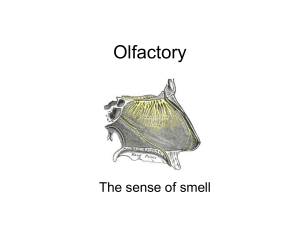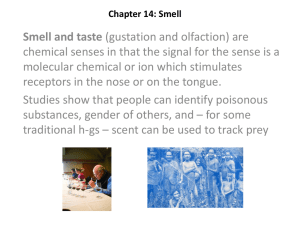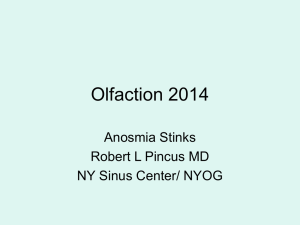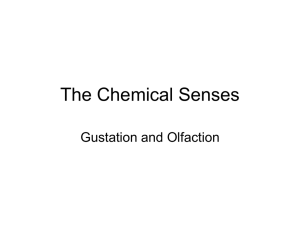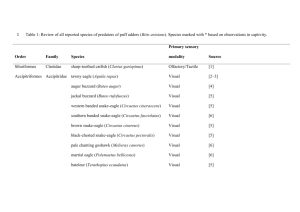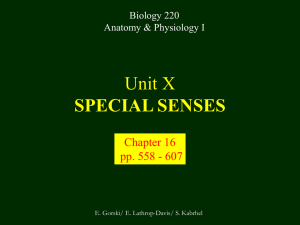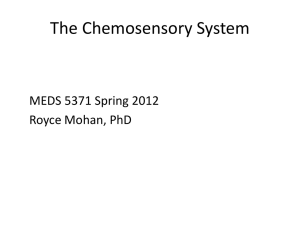Olfaction Notes
advertisement
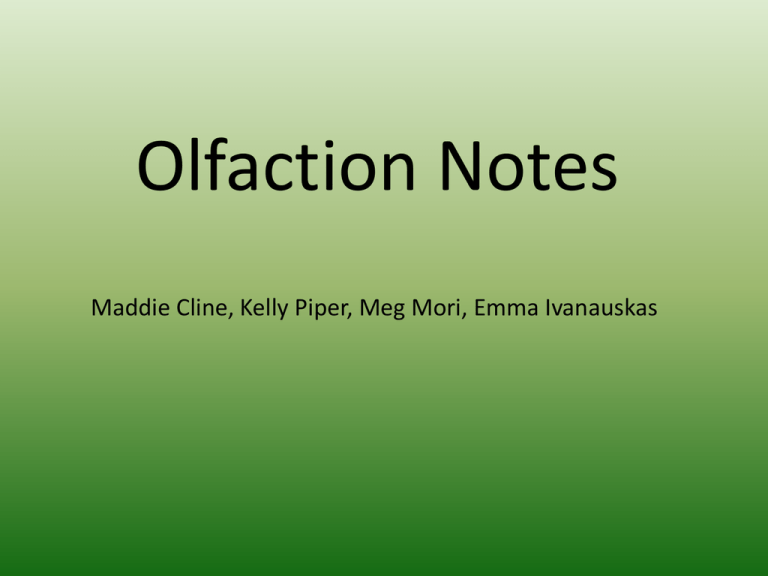
Olfaction Notes Maddie Cline, Kelly Piper, Meg Mori, Emma Ivanauskas Olfaction 5 Special Senses 1.Olfaction 2.Gustation 3.Vision 4.Equilibrium 5.Hearing Olfaction • Olfaction – the sense of smell • Our sense of smell does not compare to with dogs, cats, or fish • Provided by paired olfactory organs • Organs are located in the nasal cavity on either side of the nasal septum Olfaction Organs made up of two layers: • Olfactory epithelium • Lamina propria Olfaction Olfactory epithelium made up of: a) Olfactory receptor cells b) Supporting cells c) Regenerative basal cells (stem cells) Olfaction Lamina propria contains: a) Areolar tissue b) Numerous blood vessels c) Nerves d) Olfactory glands (Bowman’s glands) • secretions absorb water and form a thick pigmented mucus Olfaction Normal inhalation: • 2% of inhaled air to olfactory organs Sniffing increases flow of air across the olfactory epithelium and intensifies the stimulation of the olfactory receptors Olfactory Receptors • Olfactory receptor-Highly modified neuron • Larger olfactory receptor surface= better sense of smell Contains up to 20 cilia a) exposed to inhaled compounds b) site of reception (smell) c) contain odorant-binding proteins Olfactory Receptors Odorants • Chemicals that stimulate olfactory receptors • Small organic molecules Olfactory Receptors • Receptors are G proteins • Receptor binds to odorant and activates adenylate cyclase a) Converts ATP to cyclic-AMP (cAMP) • cAMP opens sodium channels in membrane… results in a localized depolarization • Action potential is triggered in the axon and smell information goes to the central nervous system (CNS) Olfactory Pathways Olfactory system is very sensitive • Stimulus does not always reach the olfactory cortex • Persistent stimulus- olfactory receptors adapt very little which causes lost awareness of a new smell Olfactory Pathways • Axons go from olfactory epithelium cribriform plate olfactory bulbs • Olfactory bulbs- where first synapse occurs • Axons leaving the olfactory bulbs go from olfactory tract to olfactory cortex (the hypothalamus) Olfactory Discrimination • Olfactory system can differentiate between 20004000 stimuli (smells) • At least 50 primary smells are known • Impossible to describe these sensory impressions Aging and Olfactory Sensitivity • New olfactory receptor cells are produced by division of basal cells in the epithelium • Total number of receptors declines with age • Receptors become less sensitive • Elderly have hard time detecting smells of low concentrations Occupations associated with Olfaction • Smell research technician- test products to see if they smell bad or good • Otorhinolaryngologist- a doctor who specializes in diseases of the ear, nose, and throat Diseases/ Conditions associated with olfaction •Deviated septum- displacement of the nasal septum or a bend causing nasal blockage on one side, post-nasal drip and trouble breathing •Choanal Atresia- nasal blockage occurring in infants affecting one side of the nose and chest retractions causing sinking of the chest •Sinus infection- inflammation, or swelling, of the tissue lining the sinuses http://www.careersearch.com/smell-researchtechnician/
